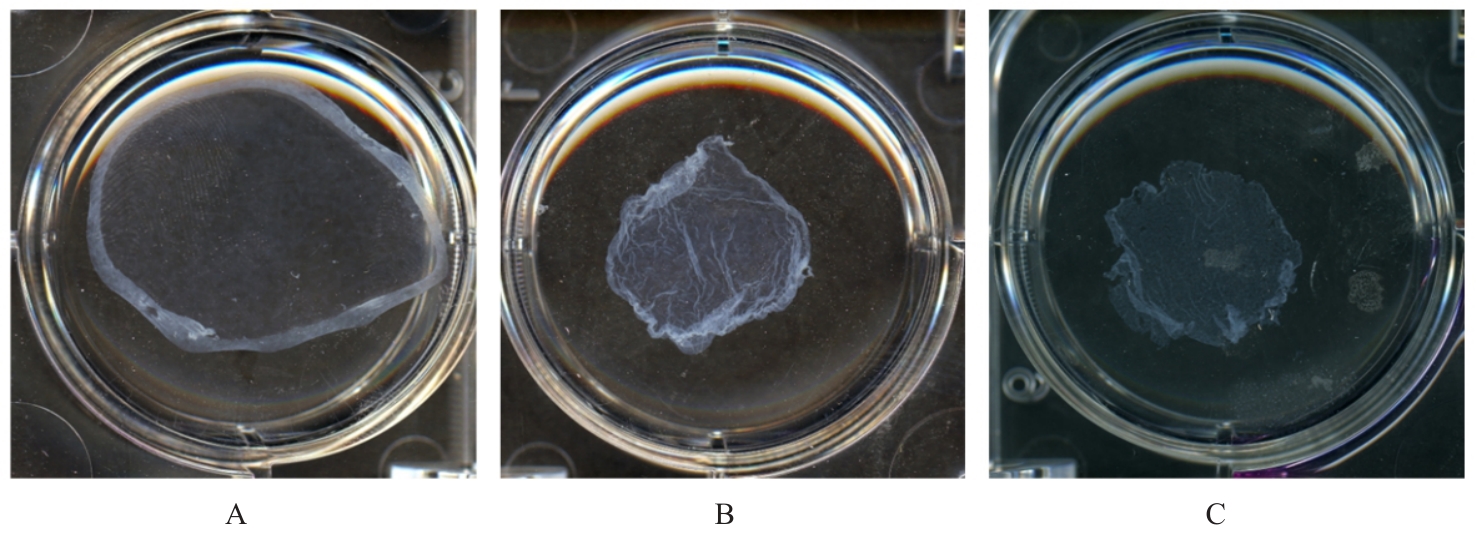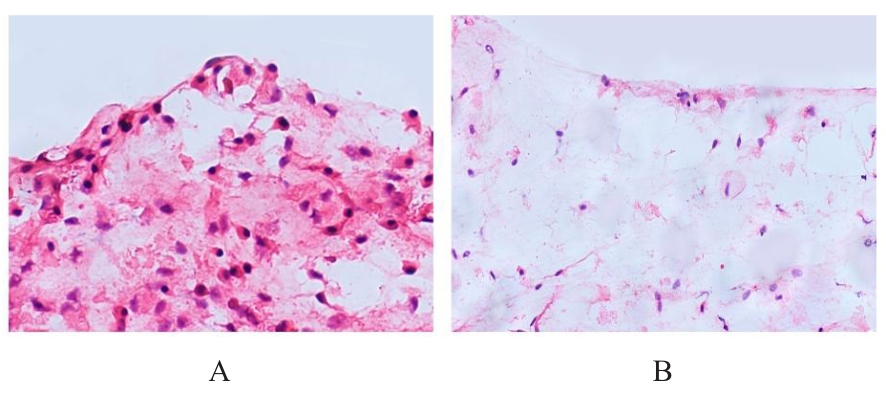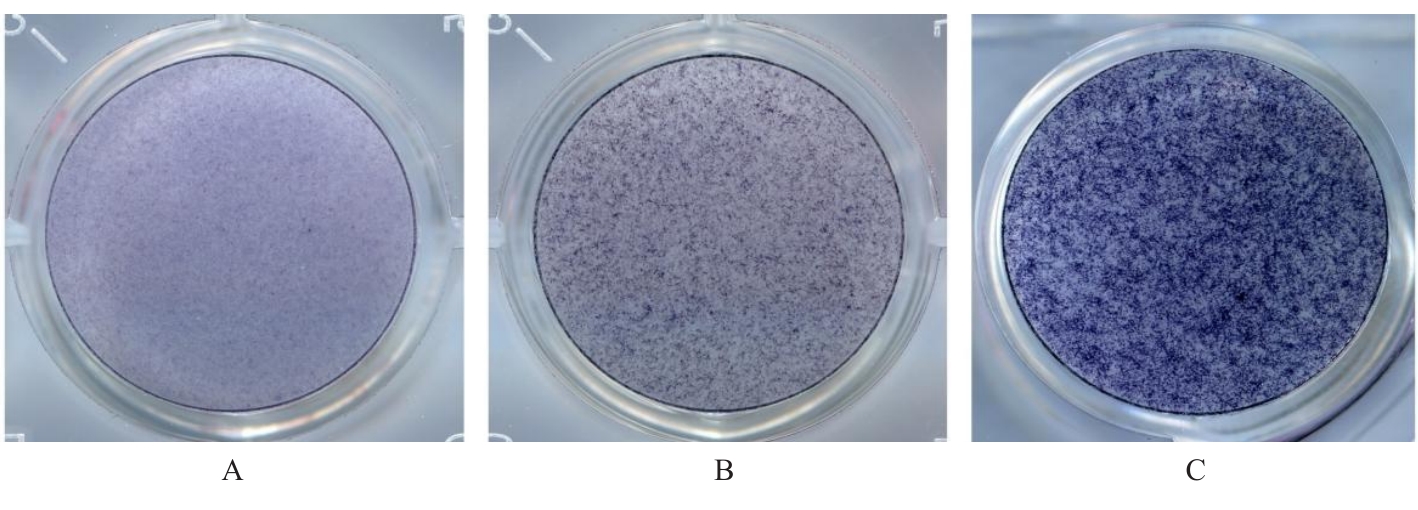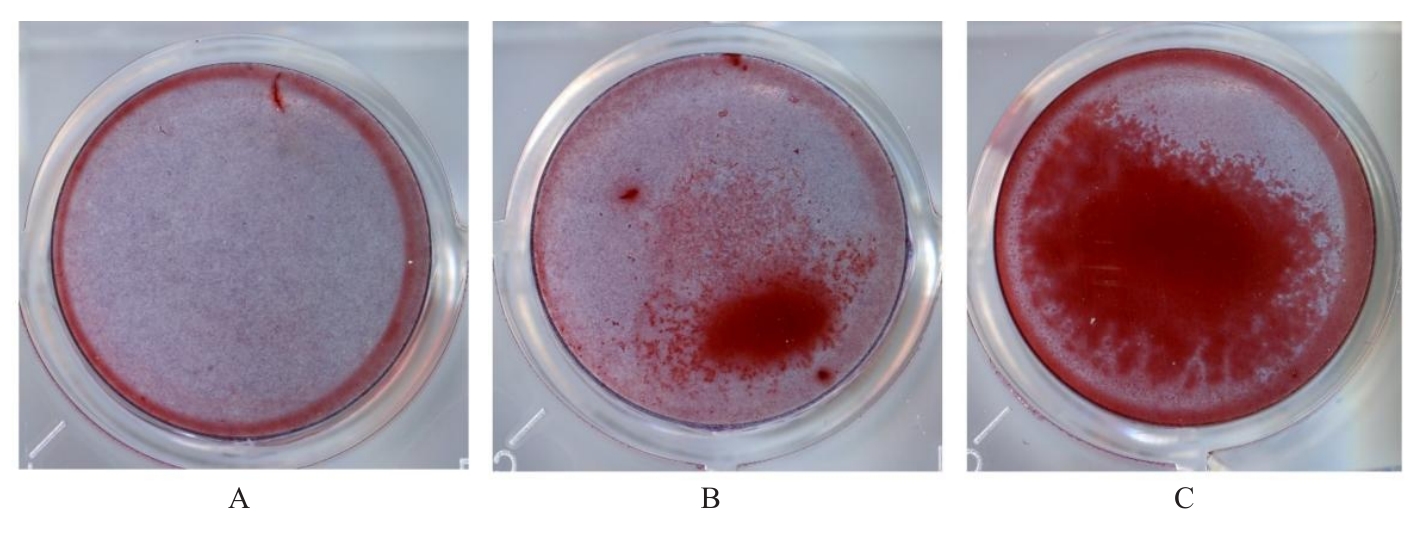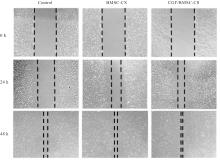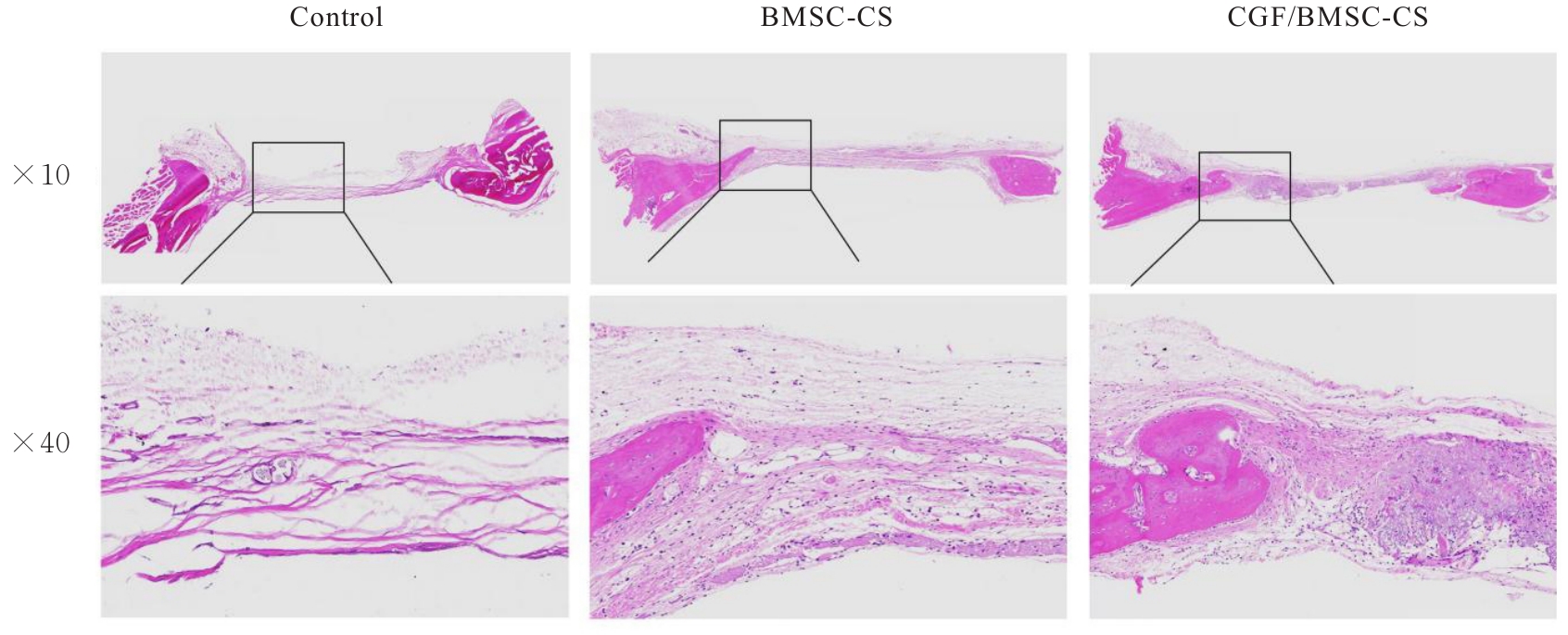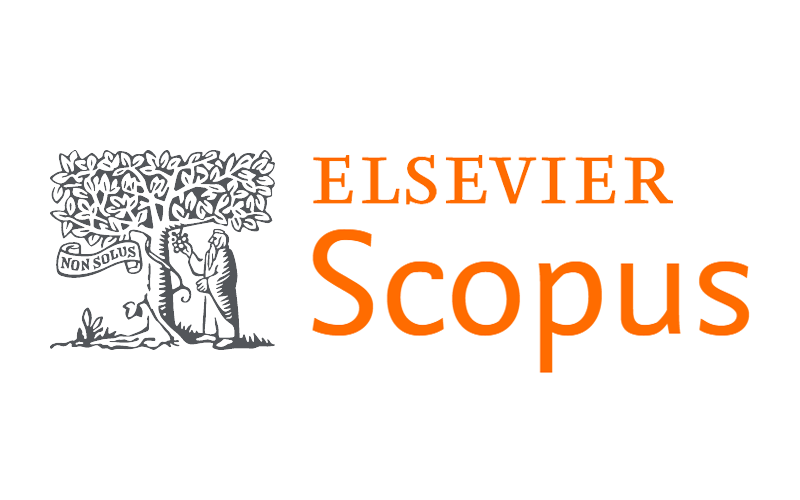Journal of Jilin University(Medicine Edition) ›› 2024, Vol. 50 ›› Issue (6): 1535-1546.doi: 10.13481/j.1671-587X.20240607
• Research in basic medicine • Previous Articles
Biological properties of concentrated growth factor combined with bone marrow mesenchymal stem cell sheet and its effect on bone defect repairment
Jianhong SHI1,2,Yuanye TIAN1,Kai CHEN1,Gao SUN1,Guomin WU1( )
)
- 1.Department of Oral and Maxillofacial Surgery and oral Plastic Surgery,Stomatology Hospital,Jilin University,Changchun 130021,China
2.Jilin Provincal Key Laboratory of Tooth Development and Bone Remodeling and Regeneration,Stomatology Hospital,Jilin University,Changchun 130021,China
-
Received:2023-12-28Online:2024-11-28Published:2024-12-10 -
Contact:Guomin WU E-mail:guominwu2006@sina.com
CLC Number:
- R78
Cite this article
Jianhong SHI,Yuanye TIAN,Kai CHEN,Gao SUN,Guomin WU. Biological properties of concentrated growth factor combined with bone marrow mesenchymal stem cell sheet and its effect on bone defect repairment[J].Journal of Jilin University(Medicine Edition), 2024, 50(6): 1535-1546.
share this article
Tab.1
Primer sequences of osteogenic related gene"
| Gene | Primer sequence |
|---|---|
| GAPDH | F 5'-AAGTTCAACGGCACAGTCAAGG-3' |
| R 5'-GACATACTCAGCACCAGCATCAC-3' | |
| ALP | F 5'-AGACTCTCAGGAGGCATAGACTTC-3' |
| R 5'-GCACAGGTTGGCGGCTTC-3' | |
| RUNX2 | F 5'-TCGTCAGCGTCCTATCAGTTCCR-3' |
| R 5'-CTTCCATCAGCGTCAACACCATC-3' | |
| OCN | F 5'-GACCCTCTCTCTGCTCACTCTG-3' |
| R 5'-CACCACCTTACTGCCCTCCTG-3' | |
| COL-1 | F 5'-TGGTCCTGCTGGCAAGAATGG-3' |
| R 5'-TCTGTCACCTTGTTCGCCTGTG-3' |
| 1 | ELLOUMI-HANNACHI I, YAMATO M, OKANO T. Cell sheet engineering: a unique nanotechnology for scaffold-free tissue reconstruction with clinical applications in regenerative medicine[J]. J Intern Med, 2010, 267(1): 54-70. |
| 2 | TAKEZAWA T, MORI Y, YOSHIZATO K. Cell culture on a thermo-responsive polymer surface[J]. Bio/Technology, 1990, 8: 854-856. |
| 3 | SEKINE H, SHIMIZU T, SAKAGUCHI K, et al. In vitro fabrication of functional three-dimensional tissues with perfusable blood vessels[J]. Nat Commun, 2013, 4: 1399. |
| 4 | AKAHANE M, NAKAMURA A, OHGUSHI H, et al. Osteogenic matrix sheet-cell transplantation using osteoblastic cell sheet resulted in bone formation without scaffold at an ectopic site[J]. J Tissue Eng Regen Med, 2008, 2(4): 196-201. |
| 5 | QI Y Y, ZHAO T F, YAN W Q, et al. Mesenchymal stem cell sheet transplantation combined with locally released simvastatin enhances bone formation in a rat tibia osteotomy model[J]. Cytotherapy, 2013, 15(1): 44-56. |
| 6 | HU T Q, ZHANG H, YU W, et al. The combination of concentrated growth factor and adipose-derived stem cell sheet repairs skull defects in rats[J]. Tissue Eng Regen Med, 2021, 18(5): 905-913. |
| 7 | RODELLA L F, FAVERO G, BONINSEGNA R, et al. Growth factors, CD34 positive cells, and fibrin network analysis in concentrated growth factors fraction[J]. Microsc Res Tech, 2011, 74(8): 772-777. |
| 8 | ROCHIRA A, SICULELLA L, DAMIANO F, et al. Concentrated growth factors (CGF) induce osteogenic differentiation in human bone marrow stem cells[J]. Biology, 2020, 9(11): 370. |
| 9 | ZHOU Y, LIU X Y, SHE H J, et al. A silk fibroin/chitosan/nanohydroxyapatite biomimetic bone scaffold combined with autologous concentrated growth factor promotes the proliferation and osteogenic differentiation of BMSCs and repair of critical bone defects[J]. Regen Ther, 2022, 21: 307-321. |
| 10 | HONDA H, TAMAI N, NAKA N, et al. Bone tissue engineering with bone marrow-derived stromal cells integrated with concentrated growth factor in Rattus norvegicus calvaria defect model[J]. J Artif Organs, 2013, 16(3): 305-315. |
| 11 | 王宇洁, 邹杰林, 蔡明轩, 等. 壳聚糖基水凝胶在口腔组织工程中的应用[J]. 中南大学学报(医学版), 2023, 48(1): 138-147. |
| 12 | WEI X B, WANG L, DUAN C M, et al. Cardiac patches made of brown adipose-derived stem cell sheets and conductive electrospun nanofibers restore infarcted heart for ischemic myocardial infarction[J]. Bioact Mater, 2023, 27: 271-287. |
| 13 | HYNES R O. The extracellular matrix: not just pretty fibrils[J]. Science, 2009, 326(5957): 1216-1219. |
| 14 | THUMMARATI P, LAIWATTANAPAISAL W, NITTA R, et al. Recent advances in cell sheet engineering: from fabrication to clinical translation[J]. Bioengineering, 2023, 10(2): 211. |
| 15 | YOU Q, LU M X, LI Z Z, et al. Cell sheet technology as an engineering-based approach to bone regeneration[J]. Int J Nanomedicine, 2022, 17: 6491-6511. |
| 16 | KIM Y, LEE S H, KANG B J, et al. Comparison of osteogenesis between adipose-derived mesenchymal stem cells and their sheets on poly-ε-caprolactone/β-tricalcium phosphate composite scaffolds in canine bone defects[J]. Stem Cells Int, 2016, 2016: 8414715. |
| 17 | NAKAMURA A, AKAHANE M, SHIGEMATSU H, et al. Cell sheet transplantation of cultured mesenchymal stem cells enhances bone formation in a rat nonunion model[J]. Bone, 2010, 46(2): 418-424. |
| 18 | CHEN L, XING Q, ZHAI Q Y, et al. Pre-vascularization enhances therapeutic effects of human mesenchymal stem cell sheets in full thickness skin wound repair[J]. Theranostics, 2017, 7(1): 117-131. |
| 19 | CHEN X, CHEN Y H, HOU Y L, et al. Modulation of proliferation and differentiation of gingiva-derived mesenchymal stem cells by concentrated growth factors: potential implications in tissue engineering for dental regeneration and repair[J]. Int J Mol Med, 2019, 44(1): 37-46. |
| 20 | DOUGLAS T E L, MESSERSMITH P B, CHASAN S, et al. Enzymatic mineralization of hydrogels for bone tissue engineering by incorporation of alkaline phosphatase[J]. Macromol Biosci, 2012, 12(8): 1077-1089. |
| 21 | CHEN X, WANG J, YU L, et al. Effect of concentrated growth factor (CGF) on the promotion of osteogenesis in bone marrow stromal cells (BMSC) in vivo [J]. Sci Rep, 2018, 8(1): 5876. |
| 22 | 胡小敏. 浓缩生长因子在口腔领域骨再生的研究进展[J]. 临床口腔医学杂志, 2023, 39(4): 252-255. |
| 23 | WINET H. The role of microvasculature in normal and perturbed bone healing as revealed by intravital microscopy[J]. Bone, 1996, 19(1 ): 39S-57S. |
| 24 | 陈春燕. 细胞减少性骨髓纤维化的治疗[J]. 中国实用内科杂志, 2023, 43(7): 540-543. |
| 25 | CHEN X, ZHANG R H, ZHANG Q, et al. Microtia patients: auricular chondrocyte ECM is promoted by CGF through IGF-1 activation of the IGF-1R/PI3K/AKT pathway[J]. J Cell Physiol, 2019, 234(12): 21817-21824. |
| [1] | Junping WEI,Dajia FU,Qingwen MENG,Daofei LIN,Yanzai LIN. Effect of bone marrow mesenchymal stem cell-derived exosomes on myocardial fibrosis in rats induced by isoproterenol and its mechanism [J]. Journal of Jilin University(Medicine Edition), 2024, 50(5): 1348-1357. |
| [2] | Hua CHEN,Na SHA,Ning LIU,Yang LI,Haijun HU. Effect of human bone marrow mesenchymal stem cells on biological behavior of human liposarcoma SW872 cells through YAP [J]. Journal of Jilin University(Medicine Edition), 2024, 50(4): 1000-1008. |
| [3] | Xiaoshuang HE,Lina XU,Mei CUI,Wenyan XIN. Inhibitory effect of BMSCs over-expressing FOXO1 on pulmonary eosinophil infiltration and airway remodeling in asthmatic mice and its mechanism [J]. Journal of Jilin University(Medicine Edition), 2023, 49(5): 1192-1201. |
| [4] | Hao ZHANG,Cuizhu WANG,Huimin HUANGFU,Xinwei ZHANG,Yidi ZHANG,Yanmin ZHOU. Effect of 20(S)-protopanaxadiol on osteogensis differentiation of bone marrow mesenchymal stem cells in rats and its mechanism [J]. Journal of Jilin University(Medicine Edition), 2023, 49(4): 867-874. |
| [5] | Wentao WANG,Xuguang MI,Yang ZHOU,Wenxing PU,Jiaxu GAO,Meng JING,Fankai MENG. Effect of autophagy induced by exosomes derived from bone marrow mesenchymal stem cells on survival of SH-SY5Y cells inhibited by MPP+ and its mechanism [J]. Journal of Jilin University(Medicine Edition), 2022, 48(3): 606-614. |
| [6] | Chongjun XU,Hefan HE,Qun LIN,Tao ZHANG. Construction of human hepatocyte growth factor gene lentivirus vector and its expression in bone marrow mesenchymal stem cells [J]. Journal of Jilin University(Medicine Edition), 2021, 47(1): 16-24. |
| [7] | SUI Xin, XU Yan, ZHOU Jia, WANG Weinan, ZHANG Mingtian, HAN Dong, LI Na, YANG Qing, QU Xiaobo, HUANG Xiaowei. Effects of velvet antler collagen typeⅠ on proliferation of bone marrow mesenchymal stem cells and its relationships with type Ⅱ collagen and aggrecan expressions [J]. Journal of Jilin University(Medicine Edition), 2020, 46(05): 992-997. |
| [8] | ZHOU Yan, JIN Lianhua, LU Na, HANG Lizhi. Comparison of differentiation effects of BMSCs into cardiomyocytes induced by three culture methods in vitro [J]. Journal of Jilin University(Medicine Edition), 2020, 46(01): 66-72. |
| [9] | GONG Qing, SONG Qiuying, QIU Lijing, HUANG Xiaowei, ZHAO Wenhai. Recovery effect of PLGA microsphere-loaded VAP combined with BMMSCs on sciatic nerve injury of rats and its mechanism [J]. Journal of Jilin University(Medicine Edition), 2018, 44(06): 1174-1178. |
| [10] | LU Bocheng, LENG Xiangyang, ZHANG Pengcheng, WANG Ying, WANG Xukai. Effect of velvet antler polypeptides combined with Schwann cells modified with GDNF gene on proliferation of human bone marrow mesenchymal stem cells in vitro [J]. Journal of Jilin University Medicine Edition, 2017, 43(06): 1125-1129. |
| [11] | ZHAO Meizi, WANG Dandan, YU Zhenjing, DUAN Yanli, MA Lina. Promotive effect of hepatocellular injury-conditioned medium on hepatic differentiation of bone marrow mesenchymal stem cells in rats [J]. Journal of Jilin University Medicine Edition, 2016, 42(06): 1108-1115. |
| [12] | ZHANG Hongchang, ZHANG Ying, LIU Mingxin, PAN Zhi, LYU Guangfu, CHEN Gang, JIANG Hongyuan, GUO Junqi. Influence of velvet antler polypeptides in expressions of BMP-2 and Runx2 in human bone marrow mesenchymal stem cells [J]. Journal of Jilin University Medicine Edition, 2015, 41(03): 491-495. |
| [13] | GU Xu, FANG Hongman, SHI Shuman, ZHANG Jiadi, WU Zhe. Effect of Ginkgo biloba extract on adipogenic differentiation ability of bone marrow mesenchymal stem cells in rats [J]. Journal of Jilin University Medicine Edition, 2015, 41(02): 343-346. |
| [14] | CHEN Hao,YIN Fei,MENG Chun-yang,ZHOU Yu-bo,ZHANG Ying,QIN Yong-gang,YANG Xiao-yu,GUO Li. Repair effect of transplantation of bone marrow mesenchymal stem cells on liver injury in severe burned rats and its mechanism [J]. Journal of Jilin University Medicine Edition, 2014, 40(02): 219-223. |
| [15] | ZHOU Yu-bo,GUO Li,MENG Chun-yang,LI Peng,LU Ri-feng,YANG Xiao-yu,YIN Fei. Effect of CdTe QDs on proliferation and osteogenesis of rat bone marrow mesenchymal stem cells [J]. Journal of Jilin University Medicine Edition, 2013, 39(2): 213-217. |
|
||



